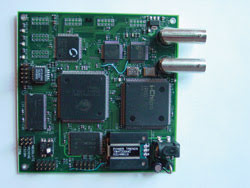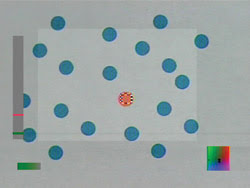Richard Gaughan, Contributing Editor
The days when an engineer needed to have a computer, a frame grabber, an operating system and a software package to inspect a manufacturing process may soon be over.
Today, companies such as Actel, Atmel, Altera, Cypress Semiconductor, Lattice Semiconductor and Xilinx are producing programmable logic devices that have densities of up to and even more than 1 million gates. Over the past few years, advances in gate densities and improvements in programming software for these devices have made the technology of programmable logic suitable for the implementation of image-processing algorithms in small, stand-alone electronic boards. These programmable devices may offer cost and speed advantages over traditional, computer-based approaches to machine vision.
At the recent Photonics West exhibition, a company called Absolute Machine Vision of San Francisco demonstrated a relatively straightforward programmable logic board (Figure 1). Rather than using a computer, the 10 × 10-cm board employs a Cypress complex programmable logic device for fast video pipelined operations, a Sumitomo C201 for real-time 7 × 7 kernel spatial convolutions and a 50-MHz Cygnal Integrated Products microprocessor for user-interface and board-housekeeping tasks.

Figure 1. Complex image processing does not necessarily require a complex computer. A stand-alone image-processing board from Absolute Machine Vision implements a sophisticated learning algorithm in programmable logic.
“The microprocessor isn’t doing much,” said Brad Smallridge, designer of the board system and vice president of North American sales at Absolute Machine Vision. “All the image processing is done in the [complex programmable logic device].”
Programmable logic comes in two flavors, complex programmable logic devices or field-programmable gate arrays. A significant difference between these two is the trade-off between speed and gate densities. Per unit cost, the former tend to be faster, but at significantly less gate density than the latter.
For the show, the company ported a patented self-learning algorithm onto the board. The algorithm, which is based in part upon RAM neural networks, can quickly learn and then identify spectral signatures. The user first “trains” the system to recognize the target color, and the system identifies objects with a different color signature and flags imperfections or discolorations. The approach has potential applications with agricultural produce, biological samples and manufactured items.
The board outputs directly to a video monitor. The processing region of interest is highlighted with slightly brighter colors. A counter bar visually indicates how many pixels do not match the learned colors, and a small color patch displays the “learned” colors (Figure 2). Discolorations, or “hits,” can be emphasized with a black or red dot. For cost-sensitive OEM and consumer applications, the board offers the ability to solve difficult image-processing jobs at a fraction of the cost of computer-based platforms.

Figure 2. The image-processing board automatically flags objects outside of an established normal range. The routine can be trained to recognize shapes or, as shown here, the spectral characteristics of acceptable objects.
Smallridge explained that the learning algorithm also processes shapes. If an image gets too complex, a typical computer-based system will slow down, but the self-learning algorithm always processes data in step with the video rate. It is especially good at discerning textural patterns with shape and color, such as those that might be found in biological samples or agricultural produce.
To prove the speed of the algorithm, the company plans to introduce a smart camera in the fourth quarter of this year that will process images at 500 full frames per second. The image sensor for this smart camera will be the MT9M413 manufactured by Micron Technology Inc. of Boise, Idaho. The 1.3-megapixel CMOS sensor requires 100 data lines operating at 66 MHz to offload more than 0.5 gigapixels per second.
Absolute Machine Vision also licenses the patented algorithm for use in new applications. “We have already licensed and had good success in the plastic cap industry,” Smallridge said. Bottle caps vary from manufacturer to manufacturer, so it is difficult to program each system for each customer. With the self-learning algorithm, he said, a manufacturer simply has to show1 the system good caps, and the process is done.
Contact: Brad Smallridge, Absolute Machine Vision, San Francisco; +1 (415) 661-8068; fax: +1 (415) 661-9079; e-mail: [email protected].